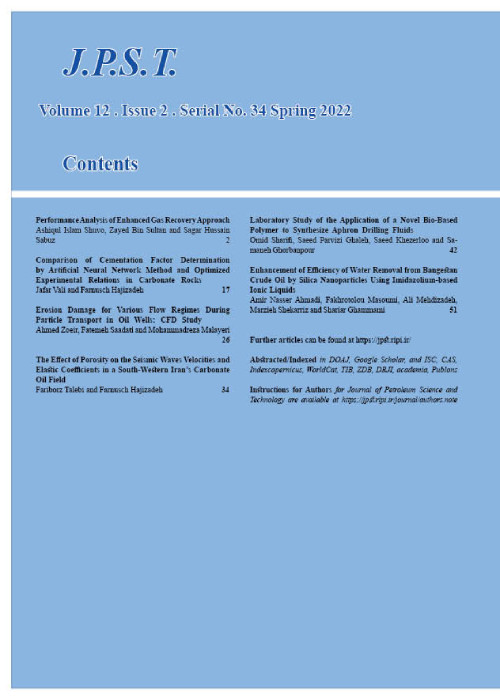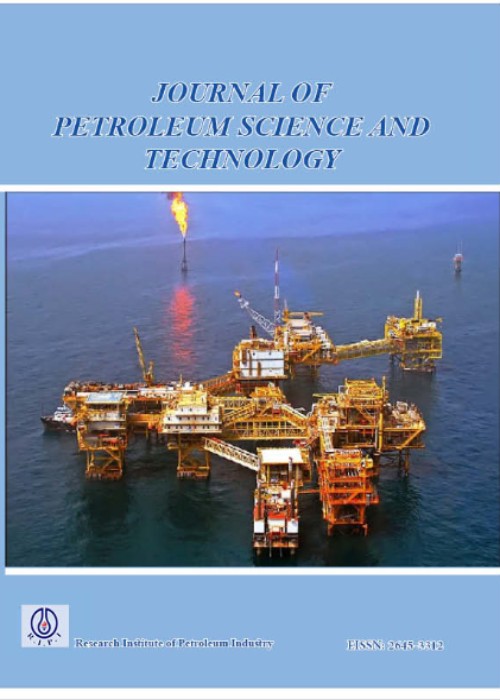فهرست مطالب

Journal of Petroleum Science and Technology
Volume:12 Issue: 2, Spring 2022
- تاریخ انتشار: 1401/12/02
- تعداد عناوین: 6
-
-
Pages 2-16Production of massive gas fields in Bangladesh is nearing to be ended in the near future.As global energy demands rise due to the rising population and rapid urbanization, maximizing available resources use has become essential. Therefore, preparing the field’s measurement to extend the field’s lifetime needs to get attention. One such measure is enhanced gas recovery (EGR); it is a potential technique to maximize the efficiency of the recovery process, which utilizes fracturing, water flooding, and gas injections to increase gas production. In this study, a simulation of the performance of three EGR techniques with linear, triangular, and corner injection well placements is presented; and thereby, the simulation results of the techniques are analyzed. Simulation of water flooding, CO2 injection, and WAG (water alternating CO2 gas) techniques are performed to evaluate the performance of the reservoir under these injections. A suggestion has been provided in favor of the suitable approach among them. The performances are evaluated based on two factors: the amount of additional gas which has been recovered and the quality of the produced gas. After analyzing the results for each case scenario, it is concluded that CO2 injection can be applied to increase natural gas recovery up to 24.55% more than the base case model. In comparison, the water flooding and WAG models contributed 16.57% and 8% more gas recovery, respectively. The EGR techniques are simulated using the GASWAT feature in the fully implicit formulation of the E300 compositional simulator, a tool of the ECLIPSE suite. Finally, by analyzing the performances of three EGR techniques, this simulation study suggests the CO2 injection model as the most suitable EGR technique over the water flooding and WAG models in terms of more gas recovery.Keywords: Enhanced Gas Recovery, CO2 flooding, Waterflooding, WAG, Injection Well Placement
-
Pages 17-25The cementation factor is one of the basic parameters for calculating water saturation and then hydrocarbon saturation of reservoirs. The best way to determine the cementation factor is through laboratory measurements. To generalize this coefficient for samples without laboratory measurements, experimental relationships versus petrophysical properties by researchers can be somewhat helpful. The method of artificial neural networks, with the help of training, validation, and data analysis, has given better results in determining the cementation factor of carbonate samples. It is one of the best methods to use petrophysical data as training data and make acceptable predictions with analytical methods. Therefore, laboratory measurement of the cementation factor has been performed for 159 carbonate cores from the Sarvak formation in southwest Iran. For the studied samples, the cementation factor in porosity was determined as a quadratic equation with the highest correlation coefficient. In this study, the compatibility of the experimental relationship shows better conformity by considering the permeability of each sample. Improvement of empirical relationships by the authors, correlation coefficients between the laboratory data, and the experimental relationships have been increased. Therefore, it is better to use improved experimental relationships for the studied carbonate samples. Artificial neural network methods have been used to process the data, best adapt the laboratory data, and present a suitable model. The Bayesian Regularization algorithm with five hidden layers has the least error in the test, validation, and testing stages.Keywords: Carbonate Rock, Cementation factor, Artificial Neural Network, Empirical Relationship, Sarvak Formation
-
Pages 26-33Oil extraction from weak sandstone formations that fails under changing in situ stresses leads to fine migration in near wellbore regions. Companies use selective completion practices or downhole filters to control particle production in oil wells. However, fines with various size dispersions will always remain that cause erosion damage in crude oil pipelines. Particles influence oil viscosity as well as density therefore impact flow regime rather than pressure drop in various depths. In this work, we employ Fluent software to simulate particle transport with the multiphase flow in the annulus that models cutting extraction during drilling rather than pipes which simulates the production process. We further estimate damage due to erosive flow under different flow regimes via adjusting various dissimilar particle dispersion functions. Results show erosion damage is at its highest value since a thin film of liquid slurry with high particle concentration forms near the inner wall pipe in the annular flow regime. Outcomes also illustrate that at high drill pipe rotation rates, flow conflicts therefore erosion damage in the annulus increases significantly.Keywords: Erosion Damage, Particle Transport, Multiphase Flow, Crude Oil Pipeline, Flow regime
-
Pages 34-41
Petrophysical and geophysical laboratory measurements were performed on ⁽40⁾ samples made of sandstone and limestone in an Oil Field. Parameters including porosity, density and permeability were measured along with the of compressional and shear waves’ velocities of the samples under reservoir conditions. Also, the study of microscopic thin sections, factors affecting the velocity of waves including porosity, Poisson’s ratio, density, pressure and pore type were investigated. The scattering of points in the velocity diagrams of elastic waves based on the petrophysical parameters of the rock indicates that the most important factor of velocity changes is the pore type in the samples in the same porosity value. So, ‹LMR› parameters were calculated using laboratory results of velocity measurement. The values of ‹LMR› parameters of seismic data were determined by the velocities of compressional and shear waves in the pre-stack stage seismic. Then, using seismic inversion, compressional and shear wave resistances were estimated and seismic sections with ‹λ.μ› and ‹μ.ρ› parameters were created. The results show that there is a good correlation between laboratory measurement of rock physics and pre-stack seismic data. Also, the factor affecting the velocity of waves, i.e., the pore types, should also be considered. Uncertainty in velocity values due to the diversity of pores can show differences in the velocity of elastic waves in the same porosity value to about ⁽1500⁾ m/s. Also, at a constant velocity, porosity changes of up to ⁽20⁾ percent are visible.
Keywords: Compressional, Shear waves Velocities, Poisson’s Ratio, Lame Coefficients, Pre-Stack, Pore Types -
Pages 42-50Aphron fluids are a special type of foam in which the gas bubble (air or any other gas) is surrounded by a double-walled layer consisting of surfactant and polymer. Therefore, it is more stable at high temperature and pressure conditions due to being preserved by three layers. These fluids are widely used in industry. Today, the industry uses various polymers such as acrylamides, polyacrylamides, and hydrolyzed acrylamides that are harmful to the environment. In this study, the possibility of using natural and biodegradable polymers such as Astragalus Gum and starch is investigated. The results showed that the Aphron fluid made from Astragalus Gum (extracted from a dessert plant) had a higher volumetric yield than industrial polymers. Stability over time and rheological properties for Astragalus Gum are also acceptable. Also, it is found that increasing the polymer concentration increases the stability and rheological properties, but in contrast, the volumetric yield decreases. The effect of salt and surfactant concentrations is also evaluated in this research. The results show that increasing the surfactant concentration increases the volumetric yield of the fluid. Increasing the surfactant concentration from 1 wt% to 2 wt% increases the volumetric efficiency of Aphron fluids by 5%. In general, according to the results obtained in this research work, Astragalus Gum’s performance is better than synthetic polymers for making Aphron fluids.Keywords: Biodegradable Polymer, Aphron Drilling Fluid, Rheological Properties
-
Pages 51-58The effect of coating silica nanoparticles by several 1-alkyl-3-methylimidazolium hexafluorophosphate ionic liquids of [Rmim][PF6] general formula (R= C10, C12, and C14) on the water removal efficiency of silica nanoparticles from crude oil emulsions have been studied in this study. The ionic liquids have been prepared and characterized by comparing their 1HNMR and FT-IR spectra with those reported in the literature. In addition, the effects of factors including cation alkyl chain length and concentration of the ionic liquids prepared on the water separation efficiency of the demulsifier have also been investigated to determine the optimal values for the chain length and concentration of the ionic liquid. [C14mim][PF6] ionic liquid at a concentration of 1200 ppm was shown to be the most efficient ionic liquid among the ionic liquids studied. The water separation efficiency achieved using coated nanosilica under optimal conditions was 93.3%.Keywords: Ionic Liquids, Demulsification, Crude Oil, Silica Nanoparticles


